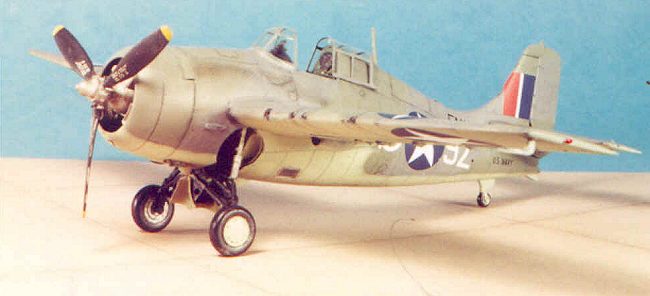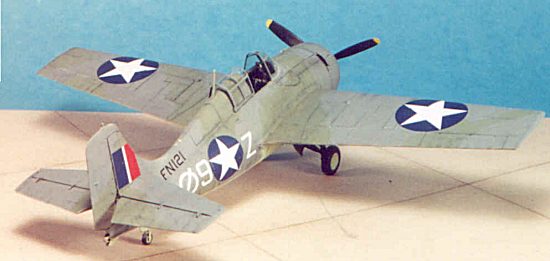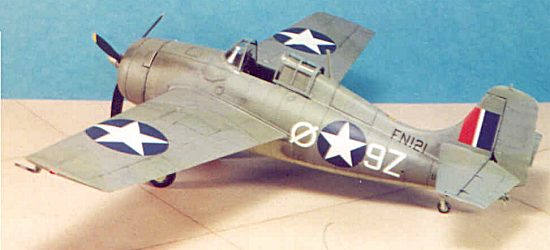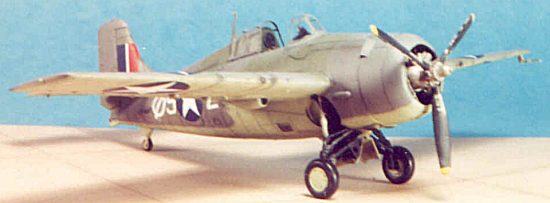
|
KIT # |
61034 |
|
PRICE: |
$26.00 |
|
DECALS: |
Eagle Strike 48-016 used ($7.00) |
|
REVIEW & |
|
|
NOTES: |
Conversion ` |

|
HISTORY |
The Fleet Air Arm was the other major user of the Grumman Wildcat during the Second World War, having placed orders for the airplane as soon as it was adopted for the U.S. Navy in 1940; known as the "Martlet" during most of its Royal Navy career, the first 80 taken on charge beginning June 27, 1940, were Martlet Is originally ordered by the French Navy; these aircraft entered squadron service in October 1940, with 804 Squadron where they replaced Sea Gladiators. A Martlet I of 804 Squadron became the first U.S. aircraft in British service to shoot down a German aircraft in the Second World War when a Ju-88A-4 was intercepted over Scapa Flow on November 27, 1940.
 The Martlet II, which was ordered directly for the Royal Navy, became the
first folding wing Wildcat, and the first to carry an armament of six .50
caliber machine guns. These aircraft proved their worth on their first cruise
aboard H.M.S. "Audacity," when the six Wildcats aboard the Royal Navy's first
escort carrier shot down one Fw-200C Condor on September 20, 1941, while
outbound to Gibraltar and later shot down an additional four on the return
voyage before "Audacity" was herself sunk by a U-boat.
The Martlet II, which was ordered directly for the Royal Navy, became the
first folding wing Wildcat, and the first to carry an armament of six .50
caliber machine guns. These aircraft proved their worth on their first cruise
aboard H.M.S. "Audacity," when the six Wildcats aboard the Royal Navy's first
escort carrier shot down one Fw-200C Condor on September 20, 1941, while
outbound to Gibraltar and later shot down an additional four on the return
voyage before "Audacity" was herself sunk by a U-boat.
The 220 Martlet IVs were the next aircraft built specifically for a British order; they were the equivalent of the U.S. Navy's F4F-4, with the exception that they were powered by a Wright GR-1829-G205A-3 Cyclone, rather than the Pratt and Whitney T-1830-86 Twin Wasp that was used in the F4F-4. The Martlet IV had a lower performance than the Twin Wasp-powered F4F-4.
Among the more memorable operations the Martlet IV participated in was Operation Torch, the Allied invasion of North Africa, with two squadrons operating from the British fleet carriers HMS "Illustrious" and HMS "Formidable." Martlet IVs also operated from HMS "Victorious" during her Pacific deployment in the Solomon Islands in 1943, during which time they provided the combat air patrol for the task group formed by "Victorious" and USS "Saratoga" during the invasion of New Georgia.
|
CONSTRUCTION |
Tamiya's Wildcat kit needs no introduction to modelers. In this writer's opinion, it is one of the best plastic model kits ever released, and certainly the best of Tamiya's newer World War II kits, with regard to overall accuracy and production quality. While there are numerous aftermarket resin cockpit sets and other items for this kit, a model built straight out of the box will be more than acceptable to most modelers - all the rest is "gilding the lily."
 The main change from what is provided in the kit is to change the cowling,
which is shorter in chord on the Martlet IV than on the F4F-4 and replace the
engine. I used a Cyclone from an old Monogram T-6 for my replacement engine in
this model.
The main change from what is provided in the kit is to change the cowling,
which is shorter in chord on the Martlet IV than on the F4F-4 and replace the
engine. I used a Cyclone from an old Monogram T-6 for my replacement engine in
this model.
The modify the cowling, the modeler needs to put off the rear portion of the cowling, at the leading edge of the cooling flaps. With the fuselage assembled, one need only glue this ring into its position on the nose, then putty over all the flap engraving and sand smooth. Then sand off the upper lip intake on the cowling, and cut out the two cooling flaps in the upper rear of the cowling.
Additionally, the Martlet IV uses a different prop from that supplied in the kit. I used a prop from an old Monogram Dauntless that was in the spares box, as it was the right size.
Once these modifications have been made, you now have a Martlet IV ready for painting.
|
PAINT & DECALS |
I painted the model with Tamiya XF-22 "RLM Grey" for Dark Slate Grey, XF-54 Flat Dark Sea Grey, and XF-21 Flat Sky. The camouflage pattern was freehanded after "preshading" the model with flat black over all panel lines. When all was dry, I gave the model two coats of Future and was ready for decals.
 Eagle Strike Decals are the new line created by the people who used to run
Aeromaster Decals, before Aeromaster went out of business when its parent
company went bankrupt. 48-016 "Grumman Martlets 1941-44, Part 1" provides
markings for four aircraft: an F4F-3A Martlet III used in North Africa, a
Martlet II, a Martlet IV flown by 893 Squadron aboard HMS "Formidable," and a
Martlet V. The Martlet IV markings are quite interesting, since US insignia was
painted over the British national markings for the North African invasion, so as
not to offend French sensibilities.
Eagle Strike Decals are the new line created by the people who used to run
Aeromaster Decals, before Aeromaster went out of business when its parent
company went bankrupt. 48-016 "Grumman Martlets 1941-44, Part 1" provides
markings for four aircraft: an F4F-3A Martlet III used in North Africa, a
Martlet II, a Martlet IV flown by 893 Squadron aboard HMS "Formidable," and a
Martlet V. The Martlet IV markings are quite interesting, since US insignia was
painted over the British national markings for the North African invasion, so as
not to offend French sensibilities.
The decals are as nice as anything made by Aeromaster, and snuggled down perfectly under a coat of Micro-Sol. When they were dry, I washed the model to get rid of solvent residue, then shot the whole thing with another coat of Future.
|
FINAL ASSEMBLY |
I glued the landing gear in position, then gave the model two coats of thinned Dullcote to flatten the glossy Future finish. I then applied gunfire stains and exhaust stains with Tamiya "Smoke," then attached the Squadron canopy in the open position.
|
CONCLUSIONS |
The Martlet IV was one of the lesser-known variants of the Wildcat, and is an easy conversion.

If you would like your product reviewed fairly and fairly quickly, please contact the editor or see other details in the Note to Contributors.